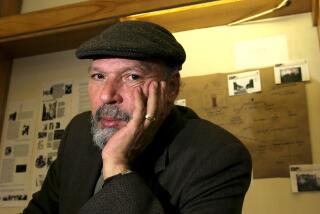The Fifties by Edmund Wilson, edited by Leon Edel (Farrar, Straus & Giroux: $25; 661 pp.)
- Share via
Alas, as I too often remind my students, there are no Cliff’s Notes to life. Happily, however, Edmund Wilson has left his voluminous notes to the middle 50 years of the 20th Century, and these can be a source of pleasure and instruction if not a guide to how to live. This fourth and penultimate volume in this series of decade-by-decade notebooks and diaries (sensibly edited by Leon Edel) provides a double record of Edmund Wilson as a man and as a writer, and while it consists of a complex, immense and, inevitably, fragmentary account of these years, the stories it tells--or implies--are essentially three: of consolidation, reconciliation and renewed creativity. By turns amusing, poignant, tedious, surprising, charming and shrewd, this uncensored document of a mind and spirit in process is further proof--if any is needed--that Wilson was a major man of letters, arguably the most important one in America in this century. He taught a generation of Americans how to read the great modernists, another generation how to understand the heroic spirit of early Socialist and Communist leaders, and yet another how to understand the American past. “Axel’s Castle” (1931), “To the Finland Station” (1940) and “Patriotic Gore” (1962) are permanent acquisitions of our culture, and even if Wilson had not written dozens of additional volumes of largely excellent fiction, poetry, plays, reviews, travel essays, autobiography and wide-ranging cultural commentary, we would still be deeply in his debt. Whatever his faults and limitations, Wilson belongs in the select and honorable company of those American Jeremiahs who have affirmed the best human values in the midst of deeply discouraging circumstances. Whatever disillusionments and weariness Wilson experienced as he entered late middle age, he continued to hunger for new alphabets, and he was always on duty.
During the 1950s, Wilson collected, expanded and published five volumes of earlier writings: “Classics and Commercials: A Literary Chronicle of the Forties” (1950), “The Shores of Light: A Literary Chronicle of Twenties and Thirties” (1952), “Five Plays” (1954), his studies in four civilizations (Zuni, Haitian, Soviet Russian and Israeli), “Red, Black, Blond and Olive” (1956), and his trenchant political and social reportage of the Depression, “The American Earthquake” (1958).
These volumes of literary consolidation had their domestic parallels. Wilson continued to live in accord with his fourth wife, Elena Thornton Mumm, whom he had married in 1946. They settled down in Wellfleet, Mass., where they spent the fall, winter and spring, and he undertook the renovation and happy occupation (usually without Elena) of the Old Stone House, the family summer home in the foothills to the Adirondacks, which he inherited when his mother died in 1951. For the first time as an adult, Wilson was able to look back from a position of some security (he was reasonably well paid by The New Yorker) and with a serenity he described as “the sweetness of life.” This sense of having arrived safely home, of having a secure place in an extended family, is the most touching development of this period of his life. The Old Stone House, most fully dealt with in “Upstate” (1972), was clearly Wilson’s “Great Good Place,” the locus of his physical, social and psychic well-being.
Reconciliation was also signaled by literary as well as personal developments. His mother had never encouraged or read Wilson, and her death is recorded briefly and without apparent emotion. (Indeed, one of the most interesting features of this “intimate” volume is an affectlessness that goes beyond disinterest or reserve. Perhaps because he knew these private writings would one day be published, they contain rather little that is private or introspective.)
Edna St. Vincent Millay had been Wilson’s early love, and her death in 1950 allowed him, as Leon Edel puts it, “a kind of final shutting of the gate on his passionate past.” But the death that affected him the most was of his mentor, Christian Gauss, whom he also memorialized in a powerful, self-revealing essay. Perhaps more important, the death of Gauss, his intellectual father, made it possible for Wilson to come to terms, at last, with his biological father, who had died more than a quarter of a century earlier. This moving paternal portrait appeared in a collection of autobiographical essays, “A Piece of My Mind: Reflections at Sixty” (1956). In lovingly evoking this gifted, successful and melancholy man, Edmund Wilson Jr. was at last able to exorcise Edmund Wilson Sr. and free himself for the “prodigies of writing” he accomplished in the balance of the decade--and for the equanimity he could enjoy with minimal guilt.
There were other reconciliations as well. Wilson had always been suspicious of Europe, and he was positively Anglophobic. But now, fortified by his international celebrity and accompanied by his European wife, he returned to England and the Continent with pleasure, visiting Max Beerbohm in Rapallo, Andre Malraux in Paris, Sir Isaiah Berlin, Cyril Connolly, E. M. Forster, Compton Mackenzie, and Angus Wilson in England. (His accounts of meetings with Robert Lowell, Faulkner, Auden, Dorothy Parker and Nabokov on this continent are equally fascinating.)
In addition, this rich volume provides engaging accounts of his visits to Israel (which yielded his popular books on the Dead Sea scrolls), and his extensive investigations of the Iroquois, which resulted in “Apologies to the Iroquois” (1960), his moving testimony on behalf of the Indians who were heroically resisting the imperial efforts of a power-mad bureaucracy. In both of these enterprises, we observe Wilson projecting his own dignified defiance of the toxic materialism, arrogance, and cynicism that he believed was increasingly poisoning American life (and letters).
In sum, this fragmentary volume should be approached as if it were a rich archeological dig. The pleasure comes not only from the recovery of bits and pieces, larger shards, or even from whole objects, but from the engagement with the intense moral intelligence and generous imagination that informs them all and connects them to other times, other places
More to Read
Sign up for our Book Club newsletter
Get the latest news, events and more from the Los Angeles Times Book Club, and help us get L.A. reading and talking.
You may occasionally receive promotional content from the Los Angeles Times.










